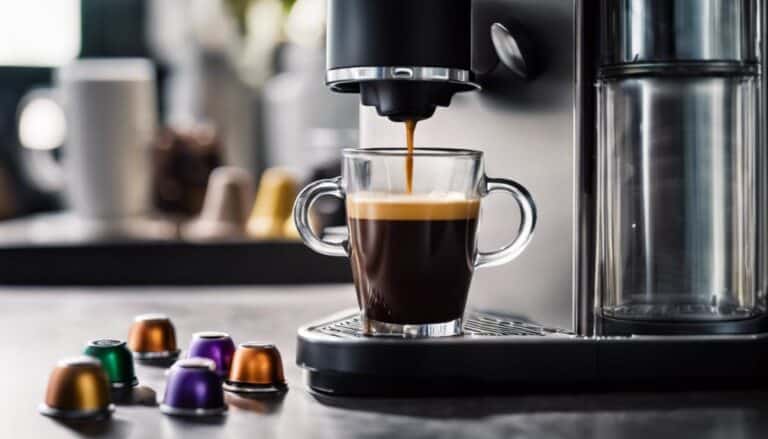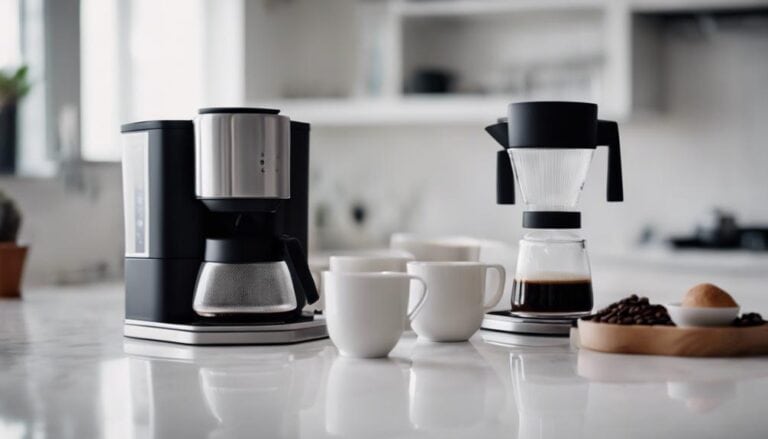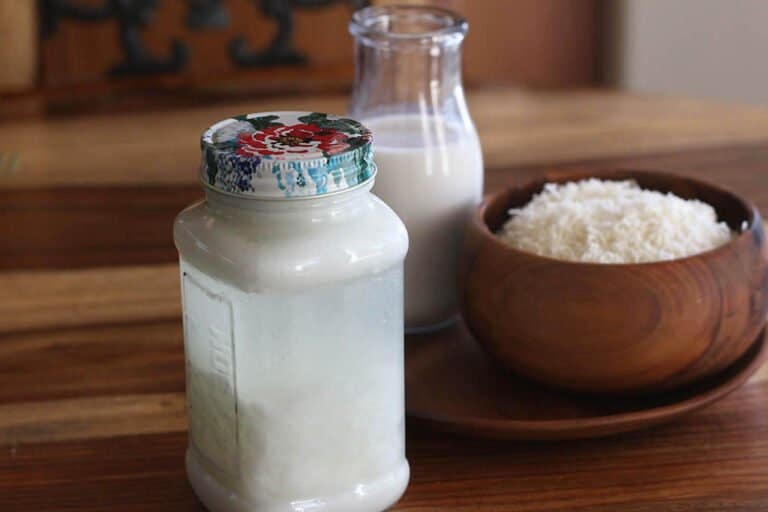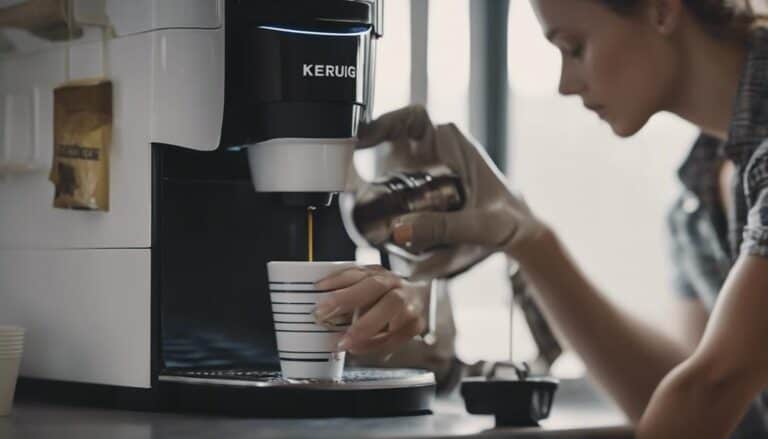How Much Caffeine in One Coffee Bean?
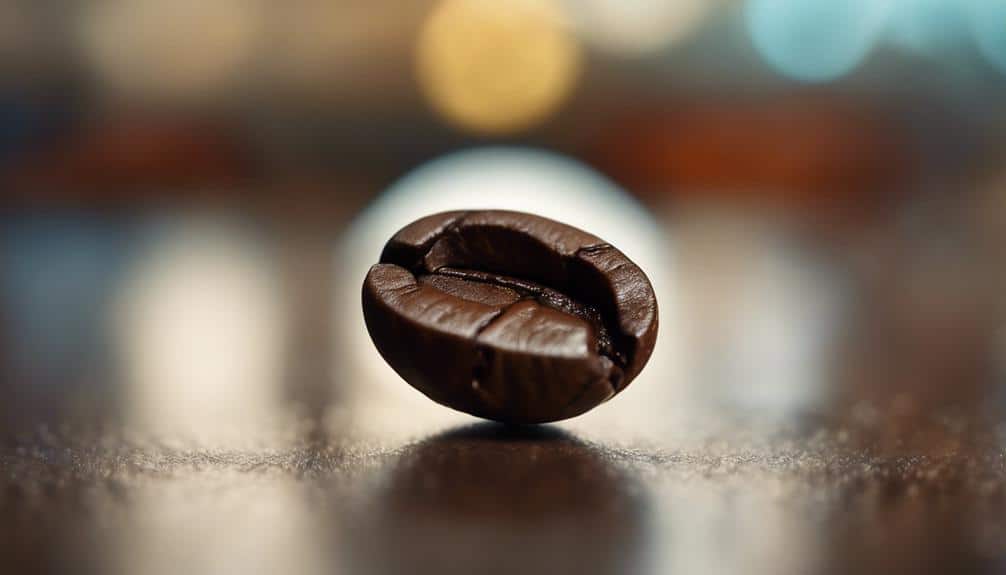
So, have you ever stopped to wonder about the caffeine content just one coffee bean holds? It's quite fascinating to think about how such a tiny bean can deliver a kick when it comes to caffeine. The distinctions between Arabica and Robusta beans might surprise you, and the factors influencing caffeine levels are equally intriguing. Let's delve into the world of coffee beans and caffeine together.
Arabica Coffee Bean Caffeine Content
Arabica coffee beans typically contain around 1.9 mg of caffeine per bean, making them a popular choice for those seeking a lower caffeine content in their coffee. This lower caffeine content in Arabica beans, ranging from 1.2 to 1.5 grams per 100 grams, is advantageous for individuals looking to enjoy the flavor of coffee without the intense kick of caffeine.
When brewed as a 250ml cup of filter coffee, Arabica coffee usually contains approximately 100 mg of caffeine. Compared to Robusta beans, Arabica beans have a milder taste profile and lower caffeine content, making them a preferred choice for those sensitive to caffeine or looking to limit their intake.
Understanding the specific caffeine levels in Arabica beans is essential for coffee enthusiasts who value customization and control over their coffee experience, allowing them to make informed decisions based on their preferences and needs. Ultimately, Arabica coffee's moderate caffeine content offers a balanced and enjoyable coffee-drinking experience for those who appreciate a smoother, less intense brew.
Robusta Coffee Bean Caffeine Levels
Robusta coffee beans boast a caffeine content of approximately 2.9 milligrams per bean. This high caffeine concentration in Robusta beans is a key factor in their bitter taste profile. Understanding the caffeine levels in Robusta beans is important for individuals seeking a more potent caffeine kick in their coffee.
- Caffeine Content Variation: The caffeine content in Robusta beans can range from 2.2 to 2.7 grams per 100 grams of beans, showing slight variability within this species.
- Comparison with Arabica Beans: Robusta beans contain higher levels of caffeine compared to Arabica beans. This difference explains why Robusta coffee is often preferred by those looking for a more robust and stimulating brew.
- Bitter Taste Association: The elevated caffeine concentration in Robusta beans contributes to their characteristic bitter taste, which is distinct from the smoother flavor profile of Arabica beans.
- Choosing Coffee Based on Caffeine Content: Being aware of the caffeine levels in Robusta beans allows coffee enthusiasts to make informed choices when selecting beans for brewing, catering to individual preferences for caffeine strength.
Understanding Coffee Bean Caffeine
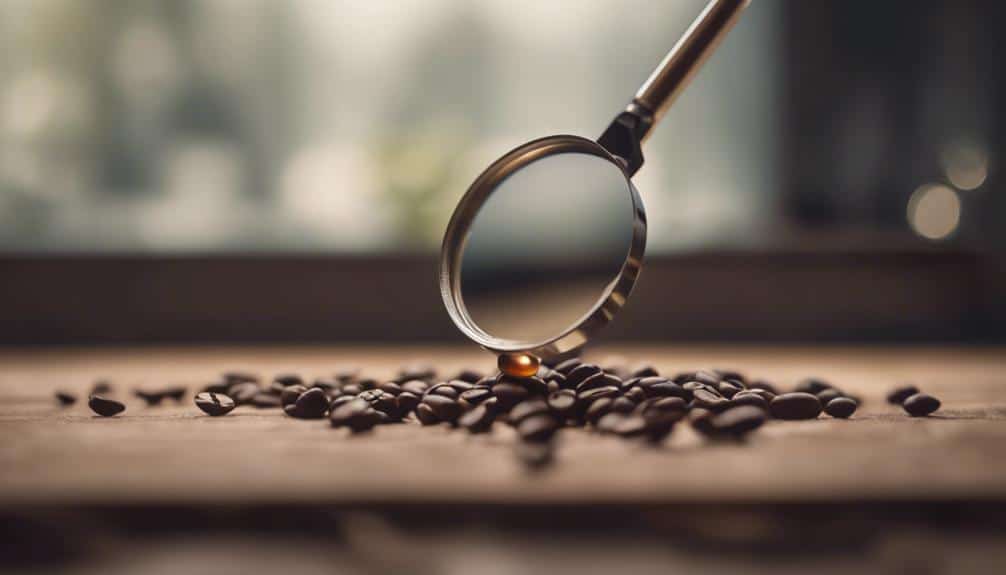
I'll now explore the variation in caffeine content within coffee beans.
I'll also delve into how the roasting process impacts this caffeine level.
Understanding these factors is essential in comprehending the caffeine intake derived from brewed coffee.
Caffeine Content Variation
In the domain of coffee bean caffeine content variation, the intricacies of origin and bean type play a substantial role in determining the amount of stimulation a cup of coffee can provide.
- Arabica coffee beans typically have lower amounts of caffeine compared to Robusta coffee beans.
- The caffeine content in coffee beans can vary greatly even within the same species due to factors like growing conditions and processing methods.
- Beans grown at higher altitudes often contain higher caffeine levels due to the stressors the plant faces, prompting increased caffeine production.
- Understanding the caffeine content in coffee beans is essential for consumers looking to tailor their caffeine intake based on their preferences and tolerance levels.
Roasting Impact on Caffeine
When examining the impact of roasting on caffeine levels in coffee beans, it becomes evident that the process itself has minimal influence on the caffeine content per bean. The caffeine levels in coffee beans are more noticeably influenced by the type of bean, whether Arabica or Robusta, rather than the roasting process.
Regardless of the roast level, a single coffee bean typically contains around 6 milligrams of caffeine. During the roasting process, the caffeine content per bean remains relatively stable.
Understanding the natural caffeine content in coffee beans is essential for appreciating the role of roasting in flavor development. Hence, while roasting plays an important role in developing the flavors of coffee, its impact on the caffeine levels per bean is minor compared to the inherent characteristics of the bean type.
Caffeine Variances in Coffee Beans
Analyzing caffeine variances in coffee beans reveals significant differences in the content per gram between Arabica and Robusta varieties. Arabica coffee beans typically have around 12 milligrams of caffeine per gram, whereas Robusta beans contain approximately 22 milligrams of caffeine per gram.
These variations in caffeine levels can impact the overall strength and flavor profile of the coffee produced from these beans. Factors such as the region where the coffee is grown, the altitude, and the processing methods can also influence the caffeine content in the beans.
Understanding these disparities is essential for coffee enthusiasts who seek specific caffeine levels in their brews. Additionally, the size and type of the coffee bean can slightly affect the caffeine content, emphasizing the importance of consistency in bean selection for achieving desired caffeine levels in coffee beverages.
Impacts of Roasting on C
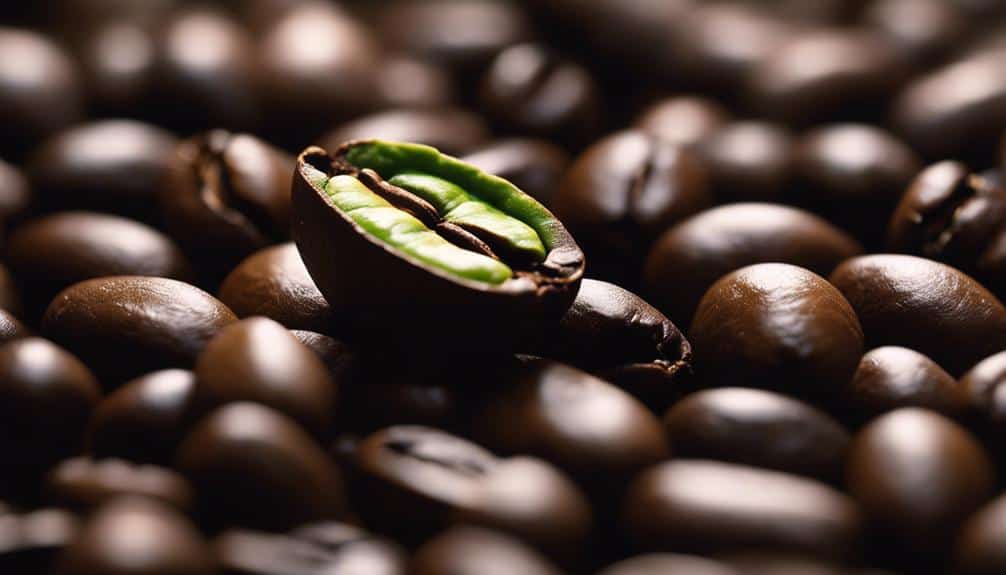
Roasting coffee beans doesn't greatly impact the caffeine content, maintaining an approximate 6 mg per bean.
Different levels of roasting don't lead to noticeable changes in caffeine levels within a single coffee bean.
The primary outcome of roasting is the enhancement of flavor compounds rather than the alteration of caffeine concentrations.
Roasting and Caffeine Levels
During the roasting process, the caffeine content in coffee beans remains relatively stable, typically ranging from 1.1% to 2.2% by weight.
Here are some key points to keep in mind regarding roasting and caffeine levels:
- Longer roasting times can lead to a slight loss of caffeine, but the difference is minimal.
- The caffeine levels in a single coffee bean tend to stay consistent irrespective of the roasting process.
- Darker roasts don't necessarily equate to lower caffeine content compared to lighter roasts.
- The primary determinant of caffeine levels in coffee beans is the type of bean itself, rather than the duration of the roasting process.
Flavor Changes in Roasting
The process of roasting coffee beans induces chemical transformations that greatly influence the flavor, aroma, and caffeine composition of the beans.
When considering flavor changes in roasting, lighter roasts generally preserve more caffeine content but exhibit a brighter, more acidic taste profile. In contrast, darker roasts offer bolder, smokier flavors, although they may contain slightly less caffeine.
The duration of the roasting process also plays a role in determining caffeine levels, as extended roasting periods can lead to a reduction in caffeine content. Understanding these variations in roasting levels is essential for achieving the desired balance between flavor profiles and caffeine concentrations in coffee beans, catering unboundedly to individual preferences.
Aroma Development in Roasting
Inducing chemical transformations during the roasting process of coffee beans triggers the breakdown of complex sugars into simpler forms, leading to the development of aromatic compounds essential for the coffee's flavor profile.
- The Maillard reactions that take place during roasting create a diverse array of aromatic compounds essential for the coffee's flavor.
- The duration and intensity of the roasting process profoundly influence the development of these aromatic compounds.
- Lighter roasts tend to retain more of the bean's original characteristics, showcasing a brighter acidity and nuanced flavors.
- Darker roasts, on the other hand, boast deeper, more robust aromas as a result of the prolonged exposure to heat during roasting.
Caffeine in Espresso Beans
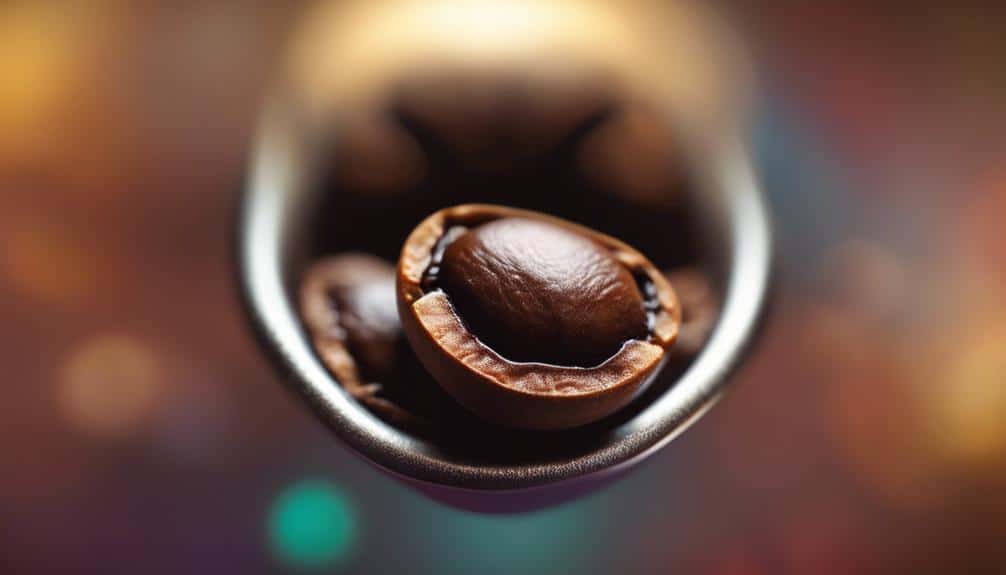
Exploring the caffeine content in espresso beans reveals that these beans typically contain approximately 6 mg of caffeine per single coffee bean. When compared, Arabica espresso beans have about 12 mg of caffeine per gram, while Robusta beans contain around 22 mg per gram. The disparity in caffeine content between the two bean types influences the final caffeine concentration in the brewed espresso. The importance of caffeine in espresso beans plays a significant role in creating the intense and robust flavor profile that espresso enthusiasts appreciate.
Dark roast coffee beans are commonly favored for espresso brewing due to their bold and rich flavors that complement the strong taste achieved through espresso brewing methods. When brewed as espresso, the caffeine content in espresso beans translates to roughly 63 mg of caffeine per shot, typically measuring around 1 ounce. Understanding the caffeine levels in espresso beans allows coffee lovers to tailor their espresso experience to their preferred intensity and flavor preferences.
Factors Affecting Caffeine in Coffee
Examining the factors that influence caffeine levels in coffee beans provides valuable insights into the complexities of caffeine content variation across different coffee varieties.
- The type of coffee bean, whether Arabica or Robusta, plays a significant role in determining the caffeine levels present. Robusta beans contain almost double the caffeine content per gram compared to Arabica beans.
- The caffeine content in a single coffee bean is approximately 6 milligrams. This value varies based on the type of coffee bean, highlighting the importance of bean selection.
- Contrary to popular belief, the roast level of coffee beans has minimal effect on the caffeine content. Whether lightly roasted or darkly roasted, the caffeine levels remain relatively consistent.
- Understanding the caffeine content in a coffee bean is important for estimating the overall caffeine intake in brewed coffee accurately. By knowing the caffeine levels in individual beans, one can better control their caffeine consumption.
Measuring Coffee Bean Caffeine

I'll discuss the variation in caffeine content among coffee beans, the influence of roasting on caffeine levels, and the impact of different brewing methods on caffeine extraction efficiency.
These points are essential in understanding how to accurately measure the caffeine content in a coffee bean and how it translates into the final cup of coffee.
Analyzing these factors will provide insight into optimizing caffeine consumption based on individual preferences and needs.
Caffeine Content Variation
Caffeine content in coffee beans greatly varies based on the type of bean, with Arabica beans containing approximately 12 milligrams of caffeine per gram and Robusta beans having around 22 milligrams per gram. When examining the caffeine content in coffee beans, several factors contribute to this variation:
- Bean Variety: Different types of coffee beans, such as Arabica and Robusta, have distinct caffeine levels per gram.
- Growing Conditions: Environmental factors like altitude and soil composition can influence caffeine content in coffee beans.
- Processing Methods: The way beans are harvested, dried, and stored can impact their caffeine concentration.
- Roasting Levels: Subsequent to measuring caffeine content, the roasting process can further alter the final caffeine amount in the beans.
Roasting Impact on Caffeine
Rarely does the process of roasting coffee beans greatly change the caffeine content per bean. The caffeine content in a single coffee bean remains relatively consistent at around 6 milligrams, regardless of the roasting level. Studies show that both light and dark roasted coffee beans contain similar amounts of caffeine per bean, indicating that the impact of roasting on caffeine levels is minimal.
Understanding this significance in caffeine content per bean is important for accurately measuring overall caffeine intake in brewed coffee. Hence, whether you prefer a light or dark roast, you can be confident that the caffeine content per bean remains relatively stable throughout the roasting process.
Brewing Extraction Methods
Brewing extraction methods significantly influence the caffeine content extracted from coffee beans.
- Espresso: Espresso extraction results in higher caffeine concentration per ounce compared to drip coffee.
- French Press: French press brewing method may lead to a more robust caffeine extraction from the beans.
- Drip Coffee Maker: Drip coffee makers typically produce a milder caffeine content per serving compared to espresso.
- Fine Grinding: Fine grinding for espresso brewing allows for more efficient caffeine extraction from the beans.
Understanding these brewing methods is vital in controlling caffeine intake from coffee beans. By selecting the appropriate method and grind size, coffee enthusiasts can tailor their caffeine consumption to suit their preferences.
Comparing Arabica Vs. Robusta Caffeine
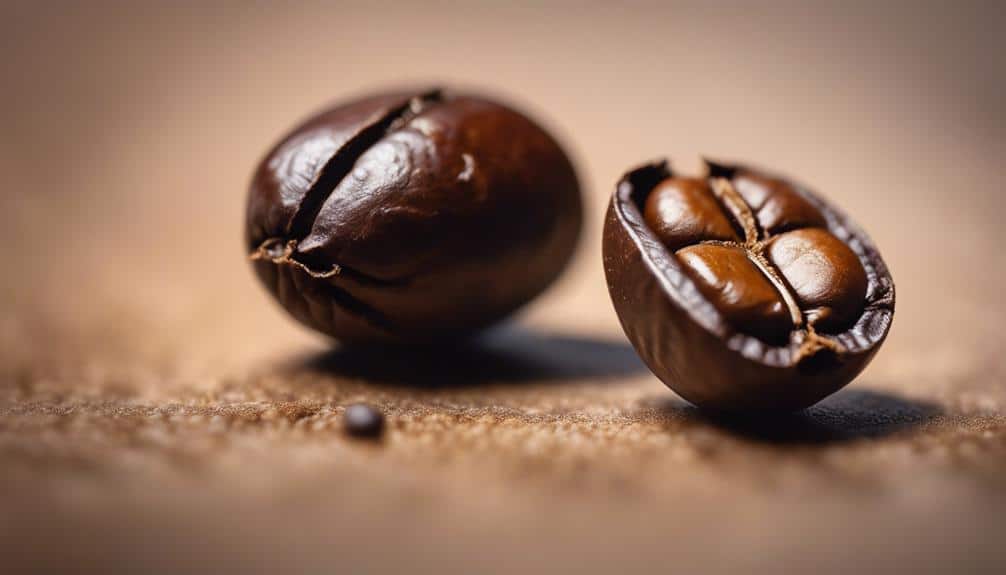
With a notable disparity in caffeine content between Arabica and Robusta coffee beans, the choice of bean can greatly impact the overall caffeine levels in a brewed cup of coffee. Arabica beans contain approximately 1.2-1.5 grams of caffeine per 100 grams, while Robusta beans have a higher caffeine content, with about 2.2-2.7 grams per 100 grams. A single Arabica coffee bean typically contains around 1.9 milligrams of caffeine, whereas a single Robusta coffee bean usually contains about 2.9 milligrams of caffeine. The caffeine levels in coffee beans vary based on the type of bean, such as Arabica or Robusta.
| Beans Type | Caffeine Content (per 100g) | Caffeine Content (per single coffee bean) |
|---|---|---|
| Arabica | 1.2-1.5 grams | 1.9 milligrams |
| Robusta | 2.2-2.7 grams | 2.9 milligrams |
Ideal Coffee for Caffeine Preferences
Selecting the appropriate coffee bean type is essential in determining the caffeine content of your brewed coffee. When looking to cater to specific caffeine preferences, considering the following factors can help guide your choice:
- Espresso Beans: Opt for espresso beans when aiming for a higher caffeine concentration in your cup. These beans are finely ground and packed into the espresso machine, resulting in a strong and intense flavor profile with a rich crema.
- Dark Roast: Dark roast coffee beans are ideal for those who enjoy a bolder and more robust flavor in their espresso. The prolonged roasting process of dark roasts brings out deep, smoky notes that complement the intense brewing method of espresso well.
- Arabica Beans: If you prefer a smoother and more nuanced caffeine experience, arabica beans are a great choice. While they contain a slightly lower caffeine content per gram compared to robusta beans, arabica beans offer a more complex flavor profile with floral and fruity notes.
- Robusta Beans: For those seeking a potent caffeine kick, robusta beans are the way to go. With a higher caffeine content per gram, robusta beans provide a stronger, more bitter flavor that can be preferred by espresso enthusiasts looking for an extra jolt.
Conclusion
In summary, understanding the caffeine content in Arabica and Robusta coffee beans is important for making informed choices based on personal preferences and tolerance levels.
Factors such as bean type, growing conditions, and processing methods all play a role in determining the caffeine levels in coffee beans.
By being aware of these variables, individuals can better control their caffeine intake and select the ideal coffee variety to suit their needs.
